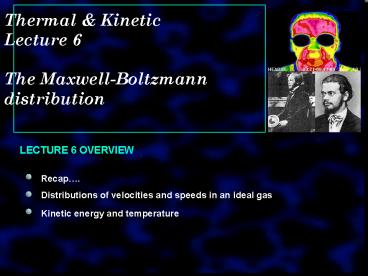Thermal - PowerPoint PPT Presentation
1 / 17
Title: Thermal
1
Thermal Kinetic Lecture 6 The
Maxwell-Boltzmann distribution
LECTURE 6 OVERVIEW
Distributions of velocities and speeds in an
ideal gas
2
Free expansion. The ideal gas law. Boltzmann
factors.
3
Boltzmann factors
Available energy is the main object at stake in
the struggle for existence and the evolution of
the world. Ludwig Boltzmann
At thermal equilibrium all microscopic
constituents of a system have the same average
energy (Grant Phillips, p. 421)
.now lets consider the distribution of energy
in the system.
4
NB. You will be expected to be able to derive
Eqn. 2.21 (i.e. Boltzmanns law) see derivation
under Section 2.3 in the notes. You have also
seen this derivation in the Mathematical
Modelling course.
Small though important typographical error in
Eqn. 2.17 should have dP dnkT
5
Boltzmann factors and distributions
Yes, but so what?
At the start of the derivation (Section 2.3) we
said that any force was appropriate thus, this
is a general expression. Assuming conservative
force.
Boltzmann factors appear everywhere in physics
(and chemistry and biology and materials science
and.) Why? Because the expression above
underlies the population of energy states and
thus controls the rate of a process.
6
Stability, metastability and instability
Potential energy
The hill represents a kinetic barrier. The ball
will only surmount the hill when it gains enough
energy. (Diamond is metastable with respect to
graphite)
7
Boltzmann factors and probability
PROBLEM You know that electrons in atoms are
restricted to certain quantised energy values.
The hydrogen atom can exist in its ground state
(E1) or in an excited state (E2, E3, E4 etc.).
At a temperature T, what is the relative
probability of finding the atom in the E3 state
as compared to finding it in the E2 state?
8
You know that electrons in atoms are restricted
to certain quantised energy values. The hydrogen
atom can exist in its ground state (E1) or in an
excited state (E2, E3, E4 etc.). At a
temperature T, what is the relative probability
of finding the atom in the E3 state as compared
to finding it in the E2 state?
- exp (E3/kT)
- exp (E2/kT)
- exp ((-E3E2)/kT)
- exp ((-E2-E3)/kT)
9
Boltzmann factors and probability
!
This is a very important value to memorise as it
gives us a handle on what processes are likely
to occur at room temperature.
The value of kT at room temperature (300 K) is
0.025 eV.
10
The distribution of velocities in a gas
Lets now return to the question of molecular
speeds in a gas.
For the time being were concerned only with
ideal gases so No interactions between
molecules
Monatomic - no internal energies no
vibrations or rotations
For an ideal gas the total energy is determined
solely by the kinetic energies of the molecules.
11
The distribution of velocities in a gas
Consider components of velocity vector. Velocity
components lie within ranges
vx ? vx dvx vy ? vy dvy vz ? vz dvz
ANS ½ mv2
12
which means that the probability of a molecule
having this energy is proportional to
- exp (-mv2/2KT)
- exp(-mvx/kT)
- exp(-mv/kT)
- exp(-mv2/kT)
13
The distribution of velocities in a gas
f(vx, vy, vz) Aexp (-mvx2/2kT) exp (-mvy2/2kT)
exp (-mvz2/2kT)
14
What is the probability that a molecule has
velocity components within the range -8 to 8?
- 0
- exp(-mv3/kT)
- 1
- None of these
15
The distribution of velocities in a gas
OK, but how do we work out what the constant A
should be.?
ANS 1
16
The distribution of velocities in a gas
and we end up with
17
Gaussian distributions
Expression for f(vx)dvx represents a Gaussian (or
normal) distribution
where ? is the standard deviation, (s
FWHM/v(8ln2)) and m is the mean.































